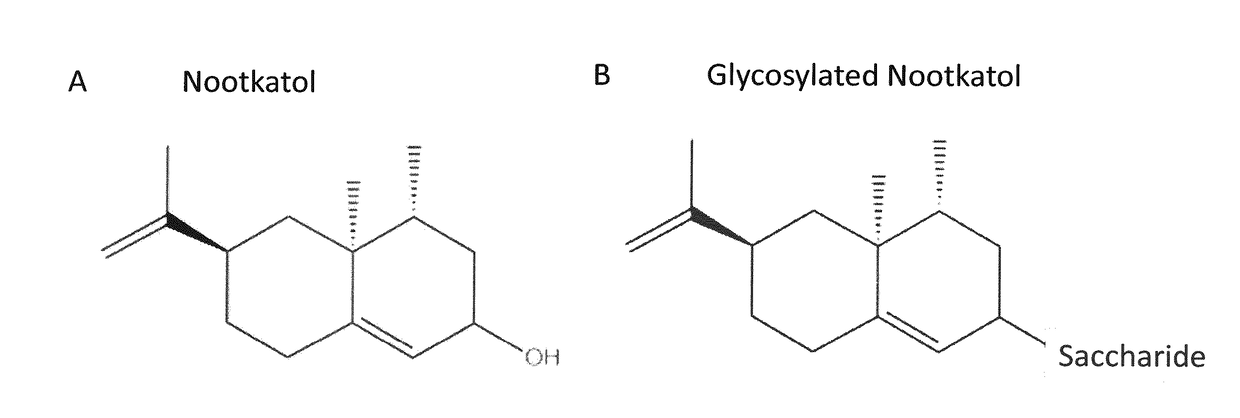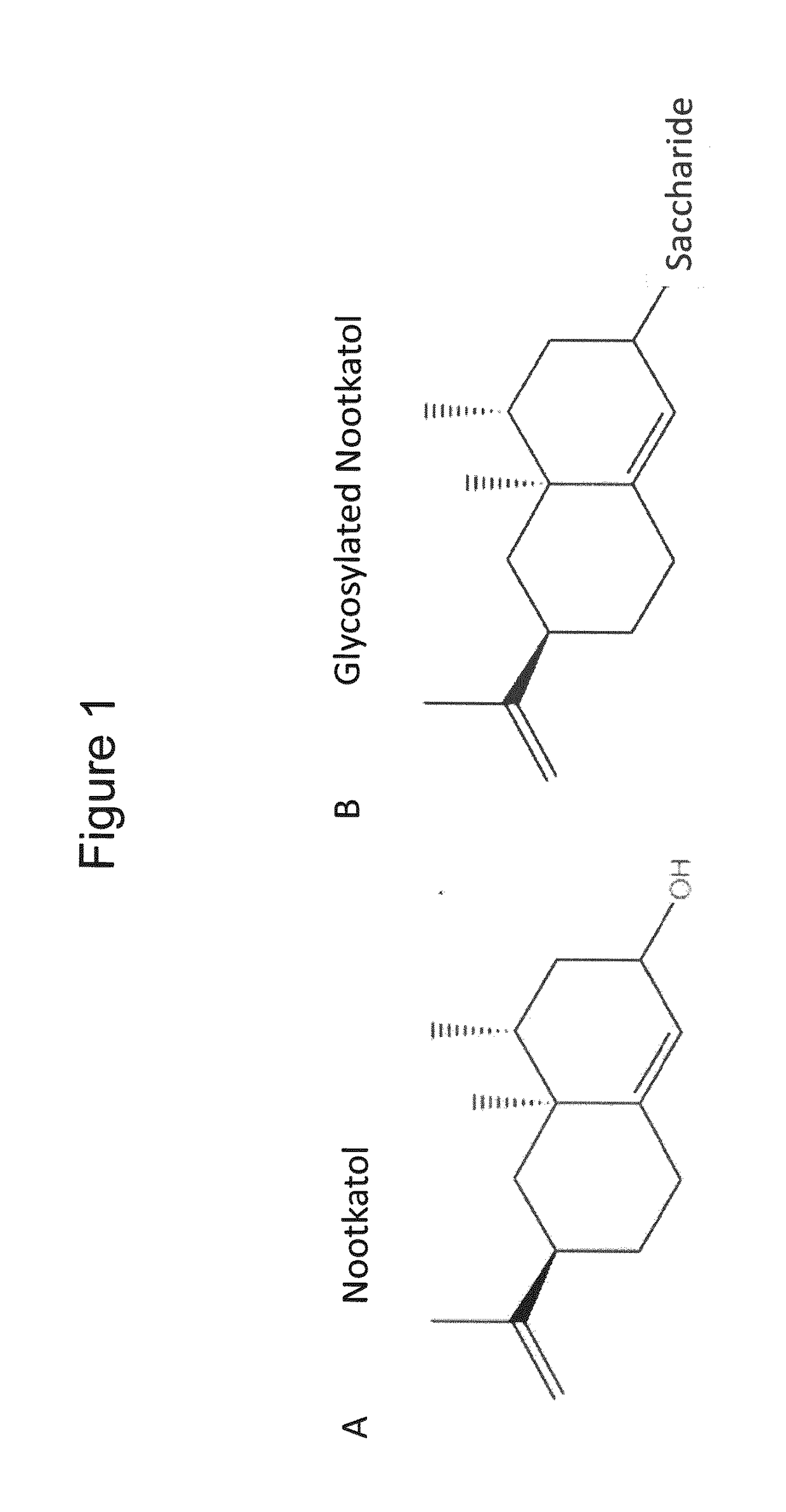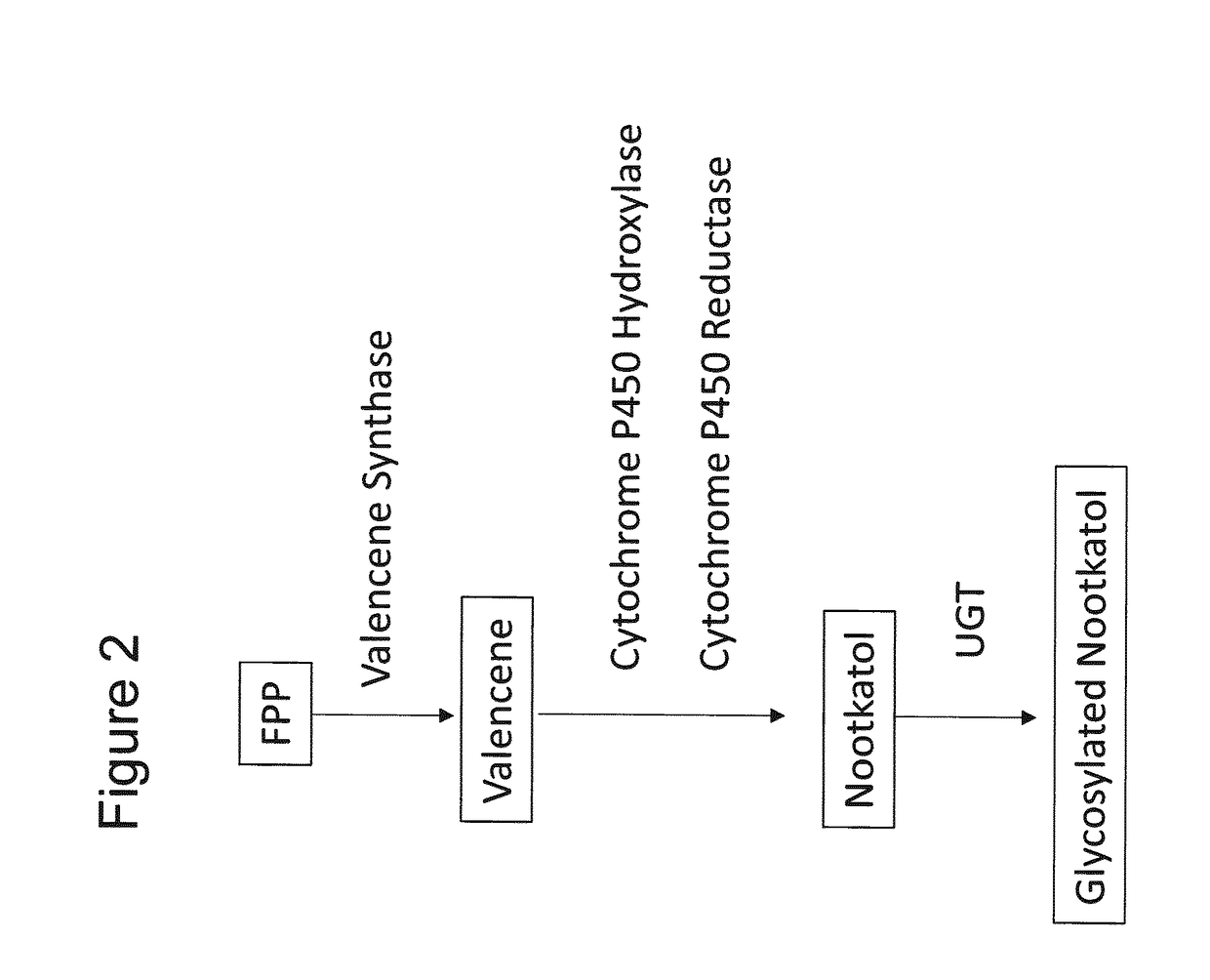Production of Glycosylated Nootkatol in Recombinant Hosts
a technology of glycosylated nootkatol and recombinant hosts, which is applied in the direction of biocide, transferase, lyase, etc., can solve the problems of high cost, labor-intensive nootkatone production, and low yield of nootkatone in yeas
- Summary
- Abstract
- Description
- Claims
- Application Information
AI Technical Summary
Benefits of technology
Problems solved by technology
Method used
Image
Examples
example 1
Glycosylation of Nootkatol
[0136]UGT85A1 (SEQ ID NO:9, SEQ ID NO:10), UGT76E1 (SEQ ID NO:11, SEQ ID NO:12), UGT73E1 (SEQ ID NO:13, SEQ ID NO:14), UGT73C3 (SEQ ID NO:15, SEQ ID NO:16), and UGT76E12 (SEQ ID NO:17, SEQ ID NO:18) were each cloned into a T7 promoter-based vector comprising a sequence coding for an N-terminal 6×His-tag. The vector backbone was linearized with restriction endonucleases, the UGT genes were amplified by PCR, and the constructs were verified by DNA sequencing.
[0137]Competent E. coli expression cells were transformed individually with a UGT-comprising plasmid. A colony from each transformation was inoculated individually in 6 mL NZCYM broth comprising an antibiotic. The pre-culture was incubated overnight at 37° C. and 220 rpm and used to inoculate 100 mL NZYCM broth with an antibiotic at an initial OD600 of 0.2. After growth at 37° C. until an OD600 of 0.6-0.8, the cells were induced for protein expression using 0.2 mM IPTG, followed by incubation at 20° C. an...
example 2
of the Growth-Inhibitory Effect of Nootkatol and Glycosylated Nootkatol on Yeast
[0140]A 20 mL seed culture of wild-type MATa strain ATCC 28383 was grown in SD-THUL medium (0.67 Bacto yeast nitrogen base without amino acids, 2% glucose, 0.14% yeast synthetic drop-out medium without uracil, tryptophan, histidine and leucine). The culture was grown for 24 h, and 2.5 mL of the culture was used to inoculate 7 equal batches of 50 mL fermentation medium (2% (NH4)2SO4, 2% KH2PO4, 0.1% NaCl, 0.6% MgSO4.7H2O, 0.4% yeast extract, 1 mL mineral solution [FeSO4.7H2O 0.028%, ZnSO4.7H2O 0.029%, CuSO4.5H2O 0.008%, Na2MoO4.2H2O 0.024%, CoCl2.6H2O 0.024%, MnSO4.H2O 0.017%, HCl 1 mL], 0.5 mL 50% glucose, 1.5 mL vitamin solution [biotin 0.001%, Ca-pantothenate 0.012%, inositol 0.06%, pyridoxine-HCl 0.012%, thiamine-HCl 0.012%], and 0.5 mL 10% CaCl2) in 250 mL baffled Ehrlenmeyer flasks.
[0141]In 6 flasks, nootkatol or glycosylated nootkatol (nootkatol+1 glucose) were added in final concentrations of 0.06...
example 4
ylation of Glycosylated Nootkatol to Generate Nootkatol
[0148]In vitro cleavage of sugar moieties of glycosylated nootkatol and subsequent isolation of nootkatol from culture medium was performed (see FIGS. 6-8) as follows.
[0149]Confirmation of reaction substrates was performed using NMR experiments in DMSO-d6 at 25° C. using a Bruker Avance III 400 MHz NMR spectrometer equipped with a 5 mm CPPBBO BB-1H / 19F / D Z-GRD probe. The structure was solved by means of one-dimensional standard homo-nuclear multipulse NMR experiments.
[0150]Identical samples of 990 μl of Delft fermentation medium further comprising 0.1 mg nootkatol-glucoside (Nootkatol-Glc) were each treated with 10 μl of 12 exemplary glycosidase enzymes (listed in Table 3 below) (thus, 1% v / v) for 2 hours. After 2 hours, samples of the reaction mixture were taken, and the de-glycosylation reaction was terminated by addition of an equal volume of ethanol followed by freezing.
[0151]The resulting digested samples were analyzed by L...
PUM
| Property | Measurement | Unit |
|---|---|---|
| Fraction | aaaaa | aaaaa |
| Mass | aaaaa | aaaaa |
| Mass | aaaaa | aaaaa |
Abstract
Description
Claims
Application Information
 Login to View More
Login to View More - R&D
- Intellectual Property
- Life Sciences
- Materials
- Tech Scout
- Unparalleled Data Quality
- Higher Quality Content
- 60% Fewer Hallucinations
Browse by: Latest US Patents, China's latest patents, Technical Efficacy Thesaurus, Application Domain, Technology Topic, Popular Technical Reports.
© 2025 PatSnap. All rights reserved.Legal|Privacy policy|Modern Slavery Act Transparency Statement|Sitemap|About US| Contact US: help@patsnap.com



